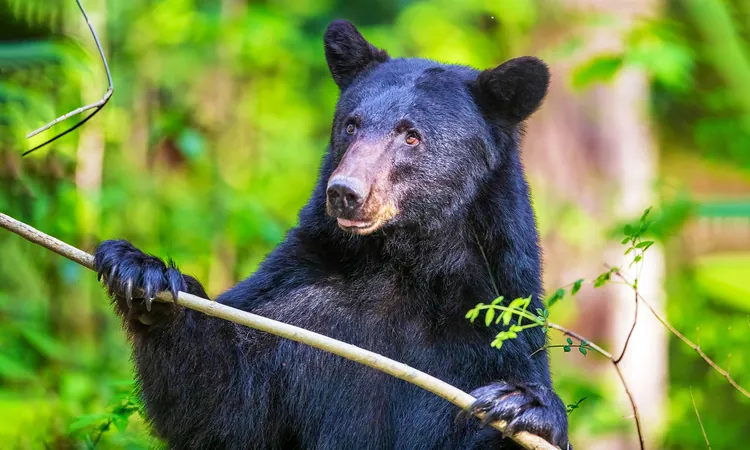
Groundbreaking Study Reveals Hidden Animal Diversity Using Airborne DNA Sampling!
2024-10-11
Author: Li
In an extraordinary breakthrough for ecological research, a team of scientists from the University of Copenhagen set out on a brisk fall morning to unveil the unseen world of animal life teeming in a Danish forest. Their unconventional mission? To “vacuum” animal DNA straight from the air. Among the researchers was Christina Lynggaard, a passionate scientist fascinated by the mysteries that surround us.
Equipped with specialized plastic boxes containing DNA air samplers, the researchers carefully affixed these devices to the trunks of trees. Once activated, the devices emitted a soft hum, drawing in air through filters specifically designed to capture microscopic DNA particles.
Over the course of three days, the team diligently returned to the site to replace the filters, driven by anticipation to discover the secrets hidden within the air samples. Despite encountering only a few visible animals during their time in the forest—a squirrel scurrying past, the drumming of a woodpecker, a clucking pheasant, and the majestic flight of a white-tailed eagle—what they revealed through their DNA analyses was astonishing.
Unlocking the Invisible Ecosystem
By sequencing the DNA trapped in the filters, the scientists uncovered signs of 64 different animal species within a surprisingly small area, roughly the size of a football field. Among the detected species were not only familiar domestic animals like cows, pigs, and dogs but also an array of wild creatures such as red deer, roe deer, Eurasian badgers, and vibrant great spotted woodpeckers.
This innovative technique had been previously tested in a controlled environment at a zoo, where the researchers had successfully mapped the DNA of numerous inhabitants. However, the transition to a wild setting posed new challenges. Professor Kristine Bohmann noted the difficulty of proving the method’s effectiveness in the vastness of nature, where animals are less concentrated.
A Answer to Biodiversity Monitoring?
The implications of this research are monumental, particularly in light of the current biodiversity crisis. Lynggaard emphasized the pressing need for tools that help track changes in ecosystems due to human activity. This non-invasive method offers a fresh way to monitor wildlife populations, essential for conservation strategies and assessing disease risks when animals come into contact with humans.
Though challenges remain, particularly ensuring the accuracy of unexpected findings—like the presence of peacock DNA, which later turned out to be corroborated by local sightings—this breakthrough marks a leap forward in environmental DNA research.
How Does It Work?
Animals shed DNA in various forms—through hair, feathers, and even skin cells—which can eventually become part of the air. By capturing and analyzing these tiny fragments, scientists can attain a realistic representation of the species inhabiting an area without needing to physically observe them.
This method is a boon for studying elusive species that are otherwise difficult to detect. Combining genetics, ecology, and technological expertise, this innovative technique underscores the importance of interdisciplinary approaches to environmental challenges.
Empowering Communities Through Citizen Science
Moreover, this groundbreaking technique offers the potential to involve local communities in scientific observation. Imagine hikers equipped with portable air samplers contributing to a global biodiversity database—a collective effort that could deepen our relationship with the environment.
As habitats shrink and species confront escalating threats, our understanding of ecosystem dynamics becomes imperative. Traditional wildlife monitoring can be invasive and resource-heavy; however, airborne DNA sampling provides a much less intrusive means of accruing crucial ecological data.
What Lies Ahead for Airborne DNA Sampling?
Excitingly, the team plans to broaden their research horizons by exploring different environments. Innovations could lead to using drones for air sampling over larger areas, revolutionizing conservation efforts on an international scale.
The idea that we can extract the secrets of life simply by sampling the air is both inspiring and motivating. As we look to the future, methodologies like this spark hope that we can confront the environmental challenges our planet faces.
So, the next time you take a breath of fresh air, remember: what you inhale might just carry the hidden stories of a vibrant ecosystem. The air isn’t empty; it’s a rich tapestry of the life that surrounds us, waiting to be explored and understood.
Conclusion
This groundbreaking study was recently published in the prestigious journal Current Biology, marking a pivotal moment in wildlife conservation and biodiversity monitoring.
Stay tuned for more thrilling discoveries in the realm of science and nature!



 Brasil (PT)
Brasil (PT)
 Canada (EN)
Canada (EN)
 Chile (ES)
Chile (ES)
 España (ES)
España (ES)
 France (FR)
France (FR)
 Hong Kong (EN)
Hong Kong (EN)
 Italia (IT)
Italia (IT)
 日本 (JA)
日本 (JA)
 Magyarország (HU)
Magyarország (HU)
 Norge (NO)
Norge (NO)
 Polska (PL)
Polska (PL)
 Schweiz (DE)
Schweiz (DE)
 Singapore (EN)
Singapore (EN)
 Sverige (SV)
Sverige (SV)
 Suomi (FI)
Suomi (FI)
 Türkiye (TR)
Türkiye (TR)